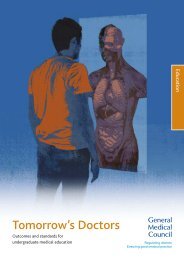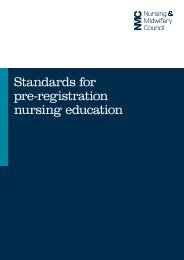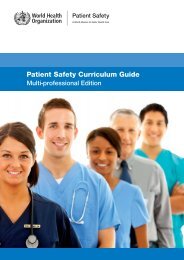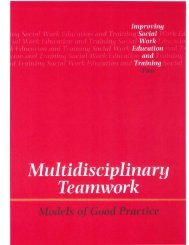Developing Interprofessional Education in health and social care ...
Developing Interprofessional Education in health and social care ...
Developing Interprofessional Education in health and social care ...
You also want an ePaper? Increase the reach of your titles
YUMPU automatically turns print PDFs into web optimized ePapers that Google loves.
4. <strong>Develop<strong>in</strong>g</strong> teach<strong>in</strong>g <strong>and</strong> learn<strong>in</strong>gNationally, a tranche of organisations (many of which were new or reconstituteddur<strong>in</strong>g the years under review) were responsible for sett<strong>in</strong>g <strong>and</strong> ma<strong>in</strong>ta<strong>in</strong><strong>in</strong>gst<strong>and</strong>ards. 5 Regionally, the organisations <strong>in</strong>cluded Local <strong>Education</strong> Consortiasucceeded by Workforce Developments Consortia <strong>and</strong> then by Strategic HealthAuthorities (disb<strong>and</strong>ed <strong>in</strong> 2011 by the Coalition Government) responsible forimplement<strong>in</strong>g government‟s workforce strategies <strong>and</strong> assign<strong>in</strong>g resources <strong>and</strong>,locally, not only universities as the education providers, but also education, <strong>health</strong><strong>and</strong> <strong>social</strong> <strong>care</strong> agencies - <strong>in</strong>dependent <strong>and</strong> statutory - as practice learn<strong>in</strong>gproviders <strong>and</strong> potential employers.Devolution of government to Scotl<strong>and</strong>, Wales <strong>and</strong> Northern Irel<strong>and</strong> resulted <strong>in</strong> thecreation of additional quasi-governmental, professional, education <strong>and</strong> other bodieswith direct or <strong>in</strong>direct <strong>in</strong>terests <strong>in</strong> IPE, each with its own policies <strong>and</strong> priorities.These are some of the many documents generated, which <strong>in</strong>dicated the trendtowards policies across professions <strong>and</strong> which were pregnant with implications forIPE: The National Service Frameworks (2000 onwards) sett<strong>in</strong>g outrequirements for <strong>care</strong> The S<strong>in</strong>gle Assessment Process for older people (Department of Health,2001); National Occupational St<strong>and</strong>ards sett<strong>in</strong>g out competencies for the <strong>health</strong><strong>and</strong> <strong>social</strong> <strong>care</strong> workforce The Knowledge <strong>and</strong> Skills Framework (Department of Health, 2004b) forNHS staff Work<strong>in</strong>g Together to Safeguard ChildrenInvestigat<strong>in</strong>g when, where <strong>and</strong> how such policies <strong>and</strong> guidel<strong>in</strong>es were brought tobear <strong>in</strong> the plann<strong>in</strong>g <strong>and</strong> delivery of IPE is beyond the scope of this report.Teach<strong>in</strong>g <strong>and</strong> facilitat<strong>in</strong>gWhile the rhetoric s<strong>in</strong>ce 2000 reasserted the case for <strong>in</strong>teraction <strong>and</strong> exchange <strong>in</strong>IPE to cultivate closer collaboration between professions, developments on theground tried to marry such comparative learn<strong>in</strong>g with common learn<strong>in</strong>g commendedby government. Common learn<strong>in</strong>g was taught <strong>in</strong> those subjects deemed to beapplicable to the needs of all or some of the constituent professional groups, e.g.5 They were: The Quality Assurance Agency for Higher <strong>Education</strong> (QAA) (see chapter 7); whosebenchmark<strong>in</strong>g statements made learn<strong>in</strong>g outcomes <strong>and</strong> assessment explicit (Yorke, 2002)<strong>and</strong> <strong>in</strong>cluded reference to <strong>in</strong>terdiscipl<strong>in</strong>ary learn<strong>in</strong>g (Davison, 2009); New <strong>and</strong> reconstituted regulatory bodies which adopted policies for IPE <strong>and</strong> collaborativepractice (see chapter 7); Royal colleges <strong>and</strong> other professional associations some of which adopted similar policies; Sector Skills Councils (Skills for Health <strong>and</strong> Skills for Care) determ<strong>in</strong><strong>in</strong>g the structure <strong>and</strong>content of vocational qualifications for employers to ensure fitness for purpose; National Institute for Cl<strong>in</strong>ical Excellence (NICE) whose guidance on cl<strong>in</strong>ical practice carriedimplications for education; National Patient Safety Agency (Department of Health, 2000).19













